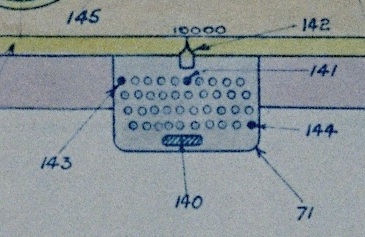Difference between revisions of "Brownrigg Keyboard"
(Created page with '[[File:BrownriggKeyboard.jpg|thumb|400px|'''Brownrigg Keyboard as fitted on a Mark IV* Dreyer Table, December 1914'''<br>A detail from a drawing in the handbook for the table to …') |
m (→Impetus and Design) |
||
| Line 25: | Line 25: | ||
==Impetus and Design== | ==Impetus and Design== | ||
| − | The [[Original Dreyer Table]] and the early revisions of the[[Mark III Dreyer Table]] had automatic plotters for range. This design, however, did not readily lend itself to permitting more than the single [[Rangefinder|rangefinder]] connected to the plotter to lend its input to the fire control problem. The practice taken in those events was to disengage the automatic plotter and to use coloured pencil marks applied by hand at the proper position{{CN}}. An effort was made to scale up the original plotter with an automatic [[Macnamara's Plotter|pneumatic plotter]] designed by Lieutenant [[Patrick Macnamara]] proved problematic, leading to a search for a simple expedient.{{CN}} | + | The [[Original Dreyer Table]] and the early revisions of the [[Mark III Dreyer Table]] had automatic plotters for range. This design, however, did not readily lend itself to permitting more than the single [[Rangefinder|rangefinder]] connected to the plotter to lend its input to the fire control problem. The practice taken in those events was to disengage the automatic plotter and to use coloured pencil marks applied by hand at the proper position{{CN}}. An effort was made to scale up the original plotter with an automatic [[Macnamara's Plotter|pneumatic plotter]] designed by Lieutenant [[Patrick Macnamara]] proved problematic, leading to a search for a simple expedient.{{CN}} |
The keyboard recorded range cuts by punching small holes in the range plot paper at the proper position. It was rather cumbersome in design. It locked into detents spaced at 1000 yard (5 inch) intervals on a bar across the range plot (a large spacebar-like key functioned to free it to move between detents). 40 smaller keys each represented a different offset at 50 yard intervals from this central position, ranging from 1000 yards below the central position to 950 above it. When any one of these was struck, a separate needle would pierce the plot at the corresponding position. | The keyboard recorded range cuts by punching small holes in the range plot paper at the proper position. It was rather cumbersome in design. It locked into detents spaced at 1000 yard (5 inch) intervals on a bar across the range plot (a large spacebar-like key functioned to free it to move between detents). 40 smaller keys each represented a different offset at 50 yard intervals from this central position, ranging from 1000 yards below the central position to 950 above it. When any one of these was struck, a separate needle would pierce the plot at the corresponding position. | ||
Revision as of 17:19, 6 September 2009

A detail from a drawing in the handbook for the table to be installed in Royal Oak.[1].
| Legend | |
| 142 | pointer to position keyboard against range scale |
| 143 | key for -1,000 yards (9,000 yards here) |
| 141 | key for index range (10,000 yards here) |
| 144 | key for +950 yards (10,950 yards here) |
| 140 | bar to reposition keyboard to another 1,000 yard detent. |
The Brownrigg Keyboard was a fairly clumsy but flexible manual means of plotting range cuts on the range plot of a Dreyer Fire Control Table invented by Command Henry John Studholme Brownrigg. It represented each observation by pricking a hole in the paper from the bottom up.
Impetus and Design
The Original Dreyer Table and the early revisions of the Mark III Dreyer Table had automatic plotters for range. This design, however, did not readily lend itself to permitting more than the single rangefinder connected to the plotter to lend its input to the fire control problem. The practice taken in those events was to disengage the automatic plotter and to use coloured pencil marks applied by hand at the proper position[Citation needed]. An effort was made to scale up the original plotter with an automatic pneumatic plotter designed by Lieutenant Patrick Macnamara proved problematic, leading to a search for a simple expedient.[Citation needed]
The keyboard recorded range cuts by punching small holes in the range plot paper at the proper position. It was rather cumbersome in design. It locked into detents spaced at 1000 yard (5 inch) intervals on a bar across the range plot (a large spacebar-like key functioned to free it to move between detents). 40 smaller keys each represented a different offset at 50 yard intervals from this central position, ranging from 1000 yards below the central position to 950 above it. When any one of these was struck, a separate needle would pierce the plot at the corresponding position.
Service Life
9 Brownrigg keyboards were ordered in early August 1914, probably going to the Mark IV and IV* tables.[2] The Brownrigg keyboards were probably on most or all Dreyer tables through the Battle of Jutland, although it is possible that some Mark III tables used the pencil-in-hand method. During 1917[Citation needed], it was replaced by the Range Typewriter, which was more elegant to use and could represent the data from up to 9 individual rangefinders with identifying marks to assist in judging the quality of the separate sources.
See Also
Footnotes
- ↑ Captain F.C. Dreyer's Fire Control Apparatus, Mark IV, Fig. V.
- ↑ Brooks. pp. 171-2 and endnote 158.
Bibliography